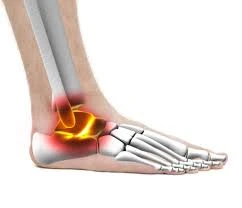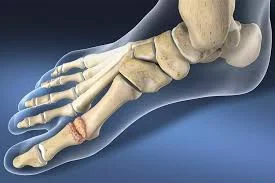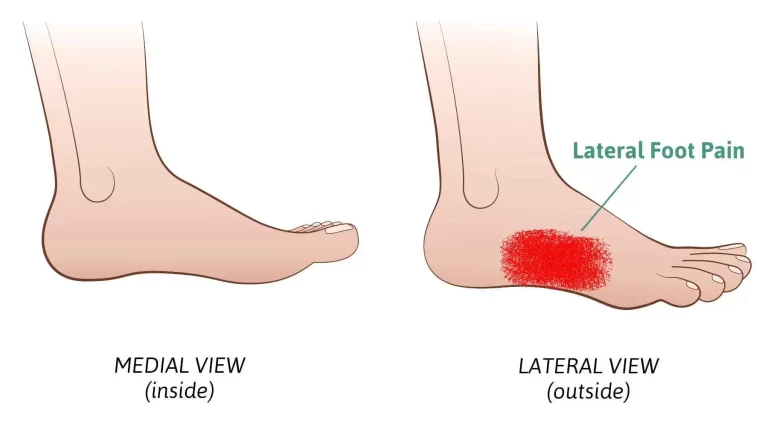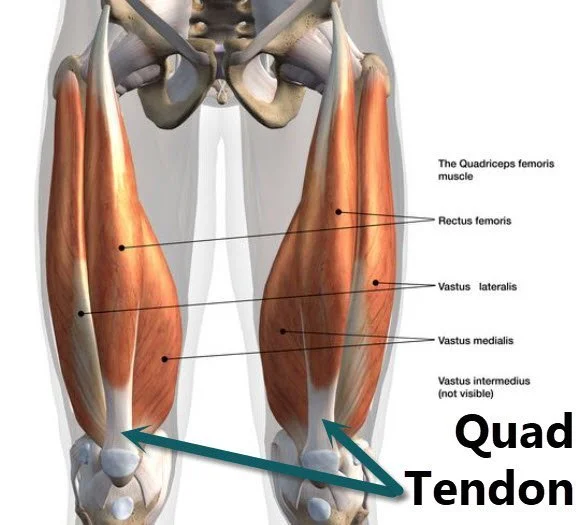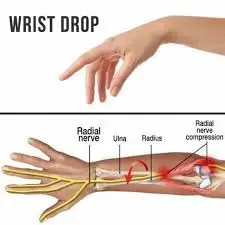Sinus Tarsi Syndrome
Definition
Sinus tarsi syndrome is a condition characterized by pain and instability in the foot, specifically in the area of the sinus tarsi, a small canal located on the lateral aspect of the ankle.
Pain or injury in this area is known as sinus tarsi syndrome. Additionally, it could happen if the person has an overpronated foot or pes planus, which can compress the sinus tarsi.
A sense of instability or trouble walking on uneven ground are among the symptoms, which include soreness at the anterior lateral side of the ankle (anterior to the lateral mallelous).
Clinically Relevant Anatomy
The sinus tarsi, a tube that runs between the talus and the calcaneus, is home to components that support the ankle’s proprioception and stability but are also susceptible to injury.
There are three facets in this articulation: an anterior, middle, and posterior facet. The calcaneofibular and deltoid ligaments, as well as the interosseus, the talo-calcaneal ligament, the cervical ligament, and the medial, lateral, and intermediate roots of the inferior extensor retinaculum, are also components of this joint. all of which provide the articulation more stability.
According to Akiyama, sinus tarsi syndrome may be caused by abnormalities in nociception and proprioception in the foot.
Epidemiology
The synovial recess in the sinus tarsi may become inflamed and bleed, and the ligaments around the area may be sprained or torn. In 70% of cases, this occurs.
Additionally, compression injuries such as flat or pronated feet can cause sinus tarsi syndrome. This results in inflammation or arthritis in the sinuses as well as bone-to-bone contact between the talus and calcaneus.
What are sinus tarsi symptoms?
The symptoms of sinus tarsi syndrome most commonly include ankle pain and swelling. The pain and swelling will be most severe on the outside bottom border of your ankle, but they may extend (radiate) to other parts of the ankle.
You will most likely be able to see and feel swelling in the region between your ankle and heel bones. The swelling might be so visible that people mistake it for a cyst or tumor under their skin.
What causes sinus tarsi syndrome?
Sinus tarsi syndrome can be caused by any injury or ailment to the subtalar joint or sinus tarsi.
Ankle sprains are the most prevalent cause. Approximately 80% of persons with sinus tarsi syndrome injured their ankle by rolling it outward, away from the center of their body. Slips, falls, and sports injuries are typical causes of ankle sprains.
Ankle injuries can also induce synovitis in the subtalar joint, which can lead to edema and sinus tarsi syndrome.
The natural structure of your foot, the way you walk, and certain health issues can all impose additional strain on your sinus tarsi, resulting in sinus tarsi syndrome over time.
- I have flat feet.
- Walking or jogging with excessive pronation.
- Arthritis of the feet and ankles.
- Obesity.
What are the risk factors?
Anyone can develop sinus tarsi, especially because ankle sprains are such prevalent ailments.
- Play a sport that requires you to twist and rapidly shift directions (such as soccer, basketball, or hockey).
- Are pregnant. Pregnant people are more likely to overpronate.
- sprain the same ankle more than once. Re-spraining a previously damaged ankle raises your chances of developing sinus tarsi syndrome.
Clinical Presentation
Ankle pain on the lateral side is one of the syndrome’s hallmarks. Since the ligaments in the sinus tarsi are the last to break with a traumatic ankle sprain, there is a significant likelihood that the lateral collateral ligaments of the ankle.
Furthermore, the subtalar joint will have more range of motion due to the ankle’s decreased stability. The forces across the sinus tarsi and onto the synovium will rise as a result of this excessive movement.
Differential Diagnosis
The following common disorders may present with similar pain features or symptoms:
- Ankle sprain
- Calcaneal fracture
- Talar fracture
- Peroneal tendonitis
- Subtalar joint arthritis
- Tarsal tunnel syndrome
Ankle instability along with pain localized to the sinus tarsi is a strong sign that the patient has developed STS. When lidocaine is injected into the sinus tarsi, the symptoms usually stop, confirming the diagnosis of STS.
Diagnostic Procedures
The usual method for diagnosing sinus tarsi syndrome is to rule out other foot disorders. Although they can rule out bone fractures, CT scans are not sensitive enough to identify STS. MRIs are the most often used technique. An MRI may reveal degenerative changes in the subtalar joint, changes in the ligament’s structure, or fluid or scar tissue filling the sinus tarsi gap.
The MRI results could also show degenerative changes in the subtalar joint and structural changes in the interosseous and cervical ligaments.
Examination
Anterolateral ankle soreness, oedema, and ecchymosis a discolouration caused on by bruising are usually evident in acute ankle injuries.
Ankle range of motion may be restricted in pronation and supination during passive examination; however, tenderness over the sinus tarsi at the end of plantar flexion in combination with supination. Identification of STS will be aided by localised ankle tenderness to the sinus tarsi space and sensations of instability with pronation and supination motions of the subtalar joint.
It is imperative for the therapist to assess for any weakening in the peroneal and plantar flexor muscles. Ankle resistance tests, such as pronation and flexion tests, are used for this.
To maintain a stable talocrural joint, the test is conducted with the participant in a supine posture with the ankle in a 10-degree dorsiflexion position. The examiner’s hand stabilises the forefoot initially, then the calcaneus receives an internal rotating force and an inversion. The forefoot is then subjected to an inversion force. The examiner looks for an overabundance of medial displacement of the calcaneus as well as a replication of the athlete’s symptoms and complaint of instability.
Treatment of Sinus Tarsi Syndrome
Medical Treatment
Both conservative and surgical methods can be used to treat sinus tarsi syndrome.
The first consists of topical gels or medications, corticosteroid injections in the sinus tarsi, and physical therapy.
In most situations, operative treatment is also highly beneficial, although it should only be used as a last option in the event that conservative treatment is ineffective. Subtalar arthroscopy is helpful in the detection and management of STS. Moreover, pathologic abnormalities in STS can be directly visualised using subtalar arthroscopy.
When conservative measures fail, open surgery and subtalar arthroscopy can be used to treat TS. All patients who underwent open excision over a 15-year period experienced 100% pain relief and no problems, according to Kuwada’s long-term therapy results for STS. According to Lowy et al., out of 21 STS patients who had open surgery, 15 of them experienced complete pain reduction, and the other 6 only saw partial relief. Furthermore, according to Frey et al., out of 21 STS patients, 43% had a good outcome and 43% had an excellent outcome following subtalar arthroscopy; only 3 patients (or 14%) had a poor outcome. Therefore, these trials indicate that both arthroscopic and open surgery result in similarly good outcomes.
Although these issues resolved with nonsurgical treatment, subtalar arthroscopy has been linked to consequences including neuritis, sinus tract development, and superficial wound infection.
Patients with STS had abnormalities in their subtalar joints, which subtalar arthroscopy revealed and demonstrated could be treated to enhance function.
Physical Therapy Treatment
Since an ankle sprain frequently precedes STS, the foot has typically taped or braced to immobilise it until the ligaments and joint heal. For this reason, when treating STS, ankle mobilisation is essential, particularly for the talocrural and subtalar joints. Exercises for joint mobilisation should be performed in all planes, but particularly in pro- and supination. Another crucial point is that, as long as there is no pain provocation, they should be performed in full range of motion.
If an activity doesn’t cause pain, it should be started as soon as possible. With sinus tarsi, the Achilles tendon and peroneal muscles tend to weaken, so it’s important to modify a program therapy to strengthen those muscles. Ankle flexion exercises performed on the toes are beneficial, and for optimal strength development, eccentric workouts performed on the stairwell’s edge can be performed. The final phase of therapy is stability training. To increase proprioception and ankle stability, the patient has to perform proprioceptive exercises like lunges. Neurological regulation, dynamic muscle reactions, and passive joint structures are necessary for joint stability.
Proprioceptive training, balance training, bracing and taping, muscle strengthening exercises, and orthotheses are all part of the STS treatment regimen. Anti-inflammatory drugs could be useful in reducing the inflammation caused by synovitis in joints experienced by certain athletes.
Surgical Treatment
Surgery is rarely required to treat sinus tarsi syndrome. If other therapies fail and you continue to suffer from extreme pain or swelling, your specialist may recommend it. They’ll explain the sort of operation you’ll require and what to expect.
Prevention
There may not be any way to avoid sinus tarsi syndrome, especially if you are an athlete. During sports and other physical activities:
- Wear suitable protective equipment (including appropriate shoes or footwear).
- Do not “play through the pain” if your ankle suffers during or after physical exercise.
- Allow your ankles to rest and recuperate after heavy activity.
- Stretch and warm up before engaging in sports or physical activities.
- Cool down and stretch after strenuous exertion.
- To lessen your chance of harm, follow these general safety precautions.
- Keep your house and workstation clean of clutter that might trip you or others.
Prognosis
Sinus tarsi syndrome often resolves as you find therapies that alleviate your symptoms. Sinus tarsi syndrome induced by an ankle sprain generally improves gradually as the injury heals. A sprained ankle might take around a month to recover. If sinus tarsi syndrome is caused by the natural form of your foot or a health problem, recovery time may be prolonged. Ask your doctor or podiatrist what to expect.
Conclusion
The sinus tarsi is a small pocket in your ankle that can produce severe pain if inflamed. Sinus tarsi syndrome occurs when an injury or other condition creates swelling in the little space between your ankle and heel bones. The most common cause of sinus tarsi syndrome is ankle sprains.
If you have ankle pain that is making it difficult to move or use your foot or ankle, see a healthcare professional or podiatrist, especially if you know you slipped, fell, or sprained it. They’ll help you figure out what’s causing your problems and explain what you can do to help your ankle recover. Sinus tarsi syndrome can be quite unpleasant, yet it is typically a transient condition.
FAQs
How does one cure sinus tarsi syndrome?
In most circumstances, your doctor will try nonsurgical therapy first. Anti-inflammatory medicines may reduce edema in the sinus tarsi. If other medications fail to ease the pain, a steroid injection may be used. An arch support can be utilized to reduce pinching at the subtalar joint.
How long does sinus tarsi syndrome take to heal?
Individuals who have surgery will often need several weeks of healing time. In some situations, it may take up to three months for them to resume sports activity, and another six to twelve months to fully recover.
Can sinus tarsi be permanent?
Sinus tarsi syndrome often resolves as you find therapies that alleviate your symptoms. Sinus tarsi syndrome induced by an ankle sprain generally improves gradually as the injury heals. A sprained ankle might take around a month to recover.
What nerve is located in the sinus tarsi?
The sinus tarsi contain ligaments, adipose connective tissue, branches of the peroneal and posterior tibial arteries that anastomose in the sinus, the cutaneous dorsolateral nerve (a branch of the superficial peroneal nerve), and proprioceptive nerve terminals.
Does ice assist with sinus tarsi syndrome?
Sinus Tarsi Syndrome treatment requires effective pain control measures. Non-surgical treatments such as rest, ice, compression, and elevation (RICE therapy), as well as physical therapy and corticosteroid injections, are frequently successful.
Can sinus tarsi produce numbness?
Ankle sprains can cause damage to other ankle ligaments and tissues. Swelling in the sinus tarsi can also press on nerves, causing symptoms like numbness, tingling, and pins & needles.
What is the clinical relevance of Sinus Tarsi Syndrome?
Sinus tarsi syndrome affects the ankle and foot and is caused by subtalar joint instability. Athletes with this ailment frequently report functional instability and chronic anterolateral ankle soreness.
How to treat sinus tarsi syndrome?
To treat sinus tarsi syndrome, you may require anti-inflammatories, supportive shoes, immobilization, ankle wraps, and over-the-counter orthotics. In certain circumstances, oral steroids, steroid injections, physical therapy, or custom orthotics may be required.
How painful is sinus tarsi syndrome?
Tarsal sinus syndrome is characterized by chronic pain and soreness around the ankle. Patients frequently report a dull, deep pain that intensifies with exercise but improves with rest.
References
- Physiotherapist, B. (2023a, February 27). Sinus tarsi syndrome : Physiotherapy Treatment. Mobile Physiotherapy Clinic. https://mobilephysiotherapyclinic.in/sinus-tarsi syndrome/
- Sinus Tarsi Syndrome. (2024, May 1). Cleveland Clinic. https://my.clevelandclinic.org/health/diseases/sinus-tarsi-syndrome

